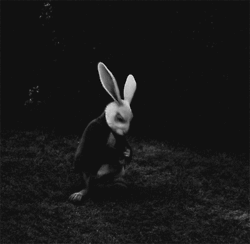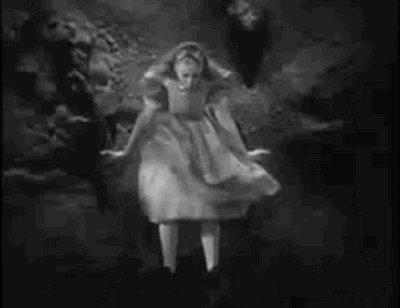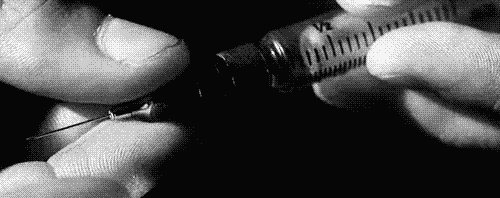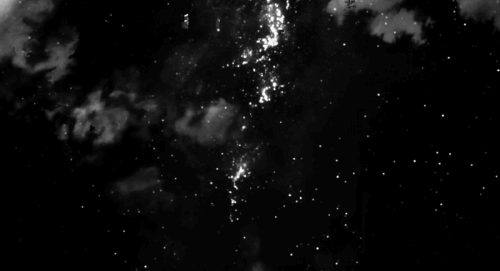| Fantasy Poetry posted January 11, 2015 |
      |
Just don't do it.
Down the Rabbit's Hole
by Dean Kuch
|
 Recognized |
Read the notes, or simply skip them all together. It matters little to me. As always, I thank you for reading and supporting my work. ~Dean Kuch
Getting involved in the music industry to the point where you're actually making money isn't easy. Staying sane, sober and drug-free when insanity, drugs and alcohol are prevalent and all around you isn't easy either. But it can be done. This work is NOT condoning the use of drugs, nor encouraging it. It's simply stating well-known, common historical facts based upon the songs of the era and the artists who performed them. Jimi Hendrix choked on his own vomit the night of September 18, 1970 and died of asphyxiation at the ripe old age of 27. Case closed...
Psychedelic rock is a style of rock music that is inspired or influenced by psychedelic culture and attempts to replicate and enhance the mind-altering experiences of psychedelic drugs.
It was pioneered by musicians including the Beatles, the Byrds, and the Yardbirds, emerging as a genre during the mid-1960's among folk rock and blues rock bands in the United Kingdom and United States, such as Grateful dead, Jefferson Airplane, the Jimi Hendrix Experience, Cream, the Doors and Pink Floyd, among a host of others. It reached a peak in between 1967 and 1969 with the Summer of Love and Woodstock Festival, respectively, becoming an international musical movement and associated with a widespread counterculture, before beginning a decline as changing attitudes, the loss of some key individuals and a back-to-basics movement, led surviving performers to move into new musical areas.
Psychedelic rock influenced the creation of psychedelic pop and psychedelic soul. It also bridged the transition from early blues-and folk music-based rock to progressive rock, glam rock, hard rock, punk rock, and as a result influenced the development of sub-genres such as heavy metal. Since the late 1970's it has been revived in various forms of neo-pshychelia.
There's lots of great music to choose from. As for the drugs... well... just don't do it!
Songs with drug references with artists:
The Beatles "Lucy in the Sky with Diamonds"-
Although it's obvious that this song (along with a majority of Beatles songs)is about a hallucinagenic, it was not LSD, but rather Angel Dust. Dust being the Diamonds (as stars look scattered across the sky). In the 70's when you took this drug, you believed you could fly. Several deaths were caused by trying.
Puff the Magic Dragon -- Peter, Paul & Mary -- This song was rumored to be about drugs, particularly marijuana. This rumor was fueled by a 1964 Newsweek article about hidden drug messages in pop music that came up with the following interpretations:
Puff's friend Jackie Paper = rolling papers
"Puff" = to take a puff from a joint
"Dragon" = a variation of "dragin'," as in taking a drag from a joint to inhale the smoke.
The band claims that the song is really about losing the innocence of childhood, and has nothing to do with drugs. At the end of the song, Puff goes back into his cave, which symbolizes this loss of childhood innocence.
Horse with no name -- America
Joy to the world -- Three Dog Night
Bennie and the Jets -- Elton John
Blinded by the Light -- Manfred Mann's Earth Band
Van Morrison's "Brown Eyed Girl"
It is a song about his love for heroin. To prove this to you I will mention a couple of facts. The word "girl" in drug culture is used for drugs that work on the brains hypothalamus region; this is the same area one feels pleasure during sexual activity. The drugs that pleasure this area are cocaine, heroin, and ecstasy. In the song he says, "slipping and a sliding" which is a description of using a needle for injection. He uses brown because heroin is normally found as a brown powder (china brown). So, before you start to make a reference to a song please research it before you put description into an artists work.
Bad Company's "Shooting Star" --
According to the lead singer, Paul Rodgers, the song is a story, and it's almost a warning. He wrote the song about the casulaties of making it in the music business and then dying of a drug overdose. At time he wrote it, he had Jimi Hendrix and Janis Joplin in mind along with other "superstars" that didn't make it.
The Jimi Hendrix Experience: "Purple Haze" (Track, 1967)
"Candy Man" -- drug pusher
"Huge Bazooms" -- large breasts
Pays
one point
and 2 member cents. Getting involved in the music industry to the point where you're actually making money isn't easy. Staying sane, sober and drug-free when insanity, drugs and alcohol are prevalent and all around you isn't easy either. But it can be done. This work is NOT condoning the use of drugs, nor encouraging it. It's simply stating well-known, common historical facts based upon the songs of the era and the artists who performed them. Jimi Hendrix choked on his own vomit the night of September 18, 1970 and died of asphyxiation at the ripe old age of 27. Case closed...
Psychedelic rock is a style of rock music that is inspired or influenced by psychedelic culture and attempts to replicate and enhance the mind-altering experiences of psychedelic drugs.
It was pioneered by musicians including the Beatles, the Byrds, and the Yardbirds, emerging as a genre during the mid-1960's among folk rock and blues rock bands in the United Kingdom and United States, such as Grateful dead, Jefferson Airplane, the Jimi Hendrix Experience, Cream, the Doors and Pink Floyd, among a host of others. It reached a peak in between 1967 and 1969 with the Summer of Love and Woodstock Festival, respectively, becoming an international musical movement and associated with a widespread counterculture, before beginning a decline as changing attitudes, the loss of some key individuals and a back-to-basics movement, led surviving performers to move into new musical areas.
Psychedelic rock influenced the creation of psychedelic pop and psychedelic soul. It also bridged the transition from early blues-and folk music-based rock to progressive rock, glam rock, hard rock, punk rock, and as a result influenced the development of sub-genres such as heavy metal. Since the late 1970's it has been revived in various forms of neo-pshychelia.
There's lots of great music to choose from. As for the drugs... well... just don't do it!
Songs with drug references with artists:
The Beatles "Lucy in the Sky with Diamonds"-
Although it's obvious that this song (along with a majority of Beatles songs)is about a hallucinagenic, it was not LSD, but rather Angel Dust. Dust being the Diamonds (as stars look scattered across the sky). In the 70's when you took this drug, you believed you could fly. Several deaths were caused by trying.
Puff the Magic Dragon -- Peter, Paul & Mary -- This song was rumored to be about drugs, particularly marijuana. This rumor was fueled by a 1964 Newsweek article about hidden drug messages in pop music that came up with the following interpretations:
Puff's friend Jackie Paper = rolling papers
"Puff" = to take a puff from a joint
"Dragon" = a variation of "dragin'," as in taking a drag from a joint to inhale the smoke.
The band claims that the song is really about losing the innocence of childhood, and has nothing to do with drugs. At the end of the song, Puff goes back into his cave, which symbolizes this loss of childhood innocence.
Horse with no name -- America
Joy to the world -- Three Dog Night
Bennie and the Jets -- Elton John
Blinded by the Light -- Manfred Mann's Earth Band
Van Morrison's "Brown Eyed Girl"
It is a song about his love for heroin. To prove this to you I will mention a couple of facts. The word "girl" in drug culture is used for drugs that work on the brains hypothalamus region; this is the same area one feels pleasure during sexual activity. The drugs that pleasure this area are cocaine, heroin, and ecstasy. In the song he says, "slipping and a sliding" which is a description of using a needle for injection. He uses brown because heroin is normally found as a brown powder (china brown). So, before you start to make a reference to a song please research it before you put description into an artists work.
Bad Company's "Shooting Star" --
According to the lead singer, Paul Rodgers, the song is a story, and it's almost a warning. He wrote the song about the casulaties of making it in the music business and then dying of a drug overdose. At time he wrote it, he had Jimi Hendrix and Janis Joplin in mind along with other "superstars" that didn't make it.
The Jimi Hendrix Experience: "Purple Haze" (Track, 1967)
"Candy Man" -- drug pusher
"Huge Bazooms" -- large breasts

You need to login or register to write reviews. It's quick! We only ask four questions to new members.
© Copyright 2025. Dean Kuch All rights reserved. Registered copyright with FanStory.

Dean Kuch has granted FanStory.com, its affiliates and its syndicates non-exclusive rights to display this work.








